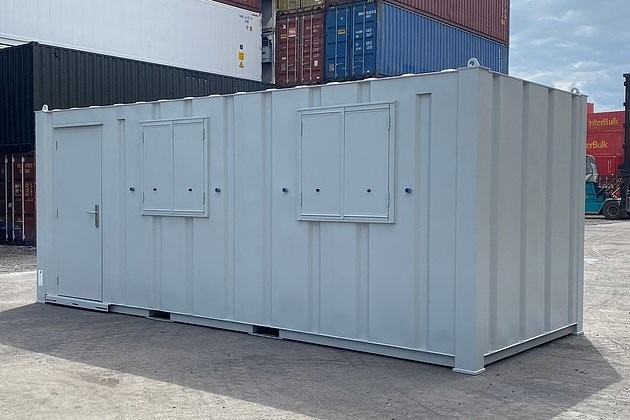
In the vast and intricate web of global trade, shipping containers are the backbone that ensures the seamless movement of goods across continents. While 20 and 40-foot containers are the most commonly recognized sizes, 30-foot shipping containers, also known as 9.14-meter containers, play a unique and vital role in the logistics industry. This article delves into the specifications, uses, and advantages of 30-foot shipping containers, providing a comprehensive overview of their significance in modern supply chains.
Introduction to 30ft Shipping Containers
A 30-foot shipping container is a standard unit of cargo transportation that measures 30 feet in length, 8 feet in width, and 8.5 feet in height. These dimensions translate to approximately 9.14 meters in length, 2.44 meters in width, and 2.59 meters in height. The container's internal dimensions are slightly smaller, typically 8.86 meters in length, 2.35 meters in width, and 2.39 meters in height. The maximum gross weight of a 30-foot container is around 30,480 kg, with a tare weight (the weight of the empty container) of about 3,520 kg, leaving a payload capacity of approximately 26,960 kg.
Specifications and Features
Dimensions:
- External Dimensions: 30' x 8' x 8.5' (9.14m x 2.44m x 2.59m)
- Internal Dimensions: 8.86' x 2.35' x 2.39' (2.70m x 2.35m x 2.39m)
- Door Opening: 7.91' x 7.91' (2.41m x 2.41m)
Weight:
- Maximum Gross Weight: 30,480 kg
- Tare Weight: 3,520 kg
- Payload Capacity: 26,960 kg
Volume:

- Cubic Capacity: 53.02 cubic meters (1,872 cubic feet)
Material:
- Body: Corrosion-resistant steel
- Floor: Plywood or wood
- Doors: Reinforced steel with weather-resistant seals
Durability:
- Designed to withstand harsh marine and overland conditions
- Equipped with corner castings for secure stacking and handling
Security:
- High-security locks and seals to prevent unauthorized access
- Optional CCTV and GPS tracking systems for enhanced security
Uses and Applications
30-foot shipping containers are versatile and can be used for a wide range of applications, both in logistics and beyond. Here are some of the primary uses:
Marine Transportation:
- Ideal for shipping medium-sized cargo, such as machinery, vehicles, and bulk goods
- Suitable for international trade routes where space efficiency is crucial
Domestic Shipping:
- Commonly used for regional and domestic freight movements
- Efficient for transporting goods between cities and states
Storage Solutions:
- Converted into temporary or permanent storage units for businesses and individuals
- Used on construction sites to store materials and equipment
Mobile Offices:
- Modified to serve as mobile offices or workspaces
- Equipped with necessary amenities like air conditioning, lighting, and internet connectivity
Housing and Tiny Homes:
- Repurposed for residential use, creating unique and cost-effective living spaces
- Used in modular construction for quick and easy assembly
Retail and Kiosks:
- Converted into retail stores, pop-up shops, and food kiosks
- Provides a mobile and customizable solution for businesses
Advantages of 30ft Shipping Containers
Optimized Space Utilization:
- Offers a balance between the payload capacity of a 40-foot container and the maneuverability of a 20-foot container
- Suitable for a wide range of cargo sizes and types
Cost-Effective:
- Generally more economical than 40-foot containers for medium-sized shipments
- Reduces handling and transportation costs compared to multiple 20-foot containers
Higher Stacking Capacity:
- Can be stacked higher than 20-foot containers, optimizing warehouse and port space
- Increased stacking capacity improves storage efficiency and reduces the need for additional storage units
Durability and Longevity:
- Built to last, with a robust design that withstands repeated use
- Suitable for long-term storage and reuse in various applications
Customizability:
- Easily modified to meet specific needs, such as adding windows, doors, or insulation
- Provides flexibility for use in different industries and settings
Environmental Benefits:
- Reusing shipping containers reduces waste and carbon footprint
- Converting containers into buildings or other structures promotes sustainable practices
Challenges and Considerations
While 30-foot shipping containers offer numerous advantages, there are also some challenges and considerations to keep in mind:
Availability:
- Not as widely available as 20 and 40-foot containers
- May require more effort to source, especially in certain regions
Port and Terminal Compatibility:
- Some ports and terminals may not be equipped to handle 30-foot containers efficiently
- Verify port and terminal capabilities before booking a shipment
Customs Regulations:
- Different countries may have varying regulations regarding the use of 30-foot containers
- Ensure compliance with local customs and transportation laws
Handling Equipment:
- Requires specific handling equipment, such as cranes and forklifts designed for 30-foot containers
- Ensure that all necessary equipment is available at both the origin and destination
Insurance:
- Confirm that insurance policies cover the unique dimensions and weight of 30-foot containers
- Check for any additional premiums or requirements
Frequently Asked Questions (FAQs)
What is the maximum weight a 30-foot shipping container can carry?
- The maximum gross weight of a 30-foot shipping container is approximately 30,480 kg, with a tare weight of about 3,520 kg. This leaves a payload capacity of around 26,960 kg.
Are 30-foot shipping containers more expensive than 20 or 40-foot containers?
- Generally, 30-foot containers are more cost-effective for medium-sized shipments compared to 40-foot containers. However, they may be slightly more expensive than 20-foot containers due to their larger size and higher payload capacity.
Can 30-foot shipping containers be stacked?
- Yes, 30-foot shipping containers can be stacked, but the stacking height may vary depending on the port and terminal regulations. They can typically be stacked higher than 20-foot containers, which optimizes storage space.
What are the common uses of 30-foot shipping containers?
- 30-foot 30Ft Shipping Containers containers are commonly used for marine and domestic transportation, storage solutions, mobile offices, housing and tiny homes, and retail and kiosks. Their versatility makes them suitable for a wide range of applications.
Are 30-foot shipping containers easy to modify for other uses?
- Yes, 30-foot shipping containers are relatively easy to modify. They can be converted into storage units, mobile offices, residential spaces, and retail kiosks with the addition of windows, doors, and other amenities.
What are the environmental benefits of using 30-foot shipping containers?
- Reusing 30-foot shipping containers reduces waste and the carbon footprint associated with new construction. They can be repurposed into buildings, storage units, and other structures, promoting sustainable practices.
30-foot shipping containers are a valuable asset in the global logistics industry, offering a balance between space efficiency and cost-effectiveness. Their versatility makes them suitable for a variety of applications, from marine and domestic transportation to storage, mobile offices, and even residential use. While there are some challenges to consider, the benefits of using 30-foot containers often outweigh the drawbacks. As the demand for efficient and sustainable logistics solutions continues to grow, 30-foot shipping containers are likely to play an increasingly important role in the movement of goods around the world.
By understanding the specifications, uses, and advantages of 30-foot shipping containers, businesses and individuals can make informed decisions about their logistics and storage needs, ultimately enhancing their operational efficiency and reducing costs.





